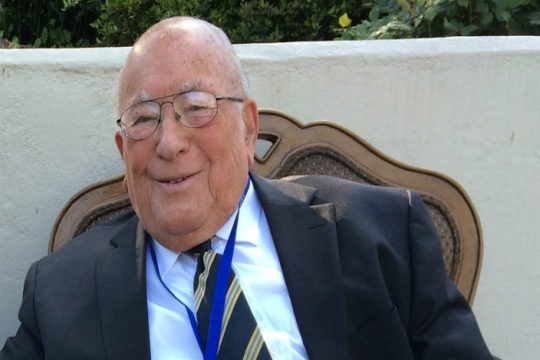
My time at the URJ Scheidt Seminar for congregational presidents and presidents-elect proved useful not only for the validation and nuts-and-bolts advice so necessary to a new congregational president, but also, to my surprise, in connecting aspects of my life, my Jewish identity, and my parents’ tragic histories.
The “Scheidt immersion,” as I came to think of it, is rightly celebrated as a necessary investment of time for any new congregational president or for someone about to assume that important role. Its relevance and benefits are multifold in its education and support of new congregational leaders and the myriad aspects of their work: fostering development and cultures of annual giving; troubleshooting congregational politics; developing early childhood programs, religious school curricula, and worship enhancements; networking, as well as advice-seeking, giving, and receiving; and so much more.
As I am the only child of Holocaust survivors, my membership in my congregation, Oak Park Temple B’nai Abraham Zion in Oak Park, IL – much less my ascent to leadership – was hardly assured. When I was a child, my father gave me a choice between tap-dancing lessons and Conservadox, after-school Hebrew classes (I still do quite a nice time-step, thank you). My cultural affiliation and identity, then, were established not by any formal Jewish youth group or synagogue participation, but by my parents (on occasion) and the environment of my New York City neighborhood. We had no close relatives with whom to celebrate Passover or Hanukkah or with whom to share Erev Rosh HaShanah dinner or break-fast. Just about everything I know about Judaism I learned at Oak Park Temple when we became members and, later, when my own children came along.
The Scheidt Seminar, for me, was the culmination of a long history of push-pull with my religious tradition and my sense of obligation to have Jewish children, given my family’s tragedy.
Having benefited tremendously from Scheidt’s intellectually stimulating sessions, conversations with wonderful people from congregations throughout North America, and vigorous and inspiring religious services, I found that my experience there, in part, deeply inspired my Yom Kippur address to the congregation – yes, the dreaded “YK appeal.” Scheidt had helped me “connect the dots,” as is said, in serving my congregation and in understanding more fully my own place among the Jewish people.
In that Yom Kippur address, I spoke about a photograph of my parents, taken sometime in the fall of 1946 in Germany. In it, both my parents are smiling. My father still has some hair, and he appears to be slender but not skinny, reasonably tall, and dapper in a sport coat and open-necked shirt. My mother is shorter, a bit round, looking to me every bit of her Polish self.
This observation about my parents’ respective “widths” alone tells me the photograph came considerable months after their individual release from concentration camps, my father from Auschwitz, my mother from, I think, Bergen-Belsen. Everyone else in their families perished.
My parents used this photograph – one of those small, scallop-edged, 1940s-style, photographs – to craft a card. The background is beige, their photo is small, and beneath it is a line of Hebrew: “L’Shanah Tovah Tikateivu.”
But to whom could or would they have even given such a card, postwar, to wish a happy new year? Other survivors, perhaps? Just about everyone else was gone.
I once asked my father why we didn’t belong to a synagogue and why he didn’t go to the local synagogue for the High Holidays the way my mother did. “I once saw people crying for God,” he told me, “and God wasn’t there.”
And yet, there is the artifact of that photograph card, which I see as a tangible, clear expression of extreme optimism for the future, and of being Jewish in the face of unspeakable atrocity and tragedy.
Somehow, my parents conveyed to me – despite our never having belonged to a congregation, despite my never having had any religious training until joining my synagogue in 1986 – that there is still optimism and importance in being Jewish. They conveyed that we as individuals and as a collective are responsible for sustaining opportunities to be Jewish and to let our Judaism flourish, however we choose to express it (or not). We are obligated to sustain opportunities for others, as well as for ourselves.
At the Scheidt Seminar, I found a compelling sense of commitment, initiative, and joy that was not only infectious but also consuming – and, ultimately, overwhelmingly optimistic about our collective Jewish future.
Beyond the practical information, the networking, and the learning, Scheidt helped me connect my parents’ remarkable and perhaps surprising optimism to my purpose as a leader. These experiences fostered my appeal to our community about our roles in sustaining it so that we all, no matter our commitment or level of belief, might thrive and keep a thriving community for generations – and, if we wish, for ourselves.
Registration is now open for the URJ’s 18th annual Scheidt Seminar for Congregational Presidents and Presidents-Elect, taking place April 7-10th, 2016 outside Atlanta, GA. Register now!
Have something to say about this post? Join the conversation in The Tent, the social network for congregational leaders of the Reform Movement. You can also tweet us or tell us how you feel on Facebook.
Related Posts

This is the Very Best Way to Start Your Term as Congregational President
